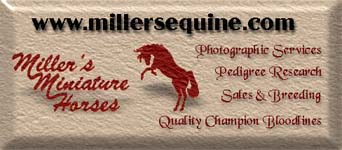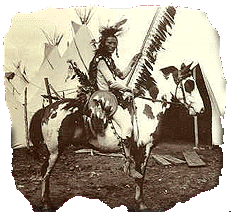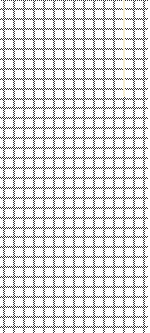PINTO & OVERO PATTERNS IN EQUINES Excerpted from Stars and Spots, by Leah Patton and Juanita Snyder
 One of the more misunderstood equine colors in the pinto. Most people could tell you that this is a white-and-color "patched" appearance. What many do not realize is that there are distinct patterns within the general definition of PINTO. It should also be noted that Pinto is the correct term for any equine bearing these general markings, while Paint is not. The Native Americans may have referred to their mounts as "painted" ponies, but in the modern world, the word paint is reserved for horses that have not only pinto markings, but distinct bloodlines as well. A horse must have Paint, Quarter Horse, or Thoroughbred ancestry to qualify as a Paint horse. Since donkeys do not meet these criteria, technically they can not be termed Paints. To have a better understanding of the Pinto patterns, the horse patterns and terminology must be explored as well. First, discard the terms piebald ( meaning a black-and-white) and skewbald (any other color and white) as they are British terms, and do not recognize any pattern involved. Pinto can also be roughly defined as horses with patched color (boken-coloured in anywhere other than the U.S.) that is not of Appaloosa appearance.
 The tobiano gene is partial dominant. Only one dose is required to produce a tobiano-marked animal. (Tt). The animal may also possess a complete dominant, or be homozygous for the tobiano gene (TT). In these cases, all offspring of the TT animal will be tobiano in pattern, reguardless of the color or pattern of the other parent. (There are tovero, which are tobiano and overo combinations, and even pintaloosa animals, which have both pinto and appaloosa markings). Recent research points to the visual indicator of the TT (homozygous) tobiano as being the "paw prints" or "ink spots", small random dark markings in the white areas of the patterning.
 OVERO: The horse will be of any solid color, with an extensively marked face (usually bald or apron, more than a blaze). White appears on the belly or midline, spreading up and outward. Secondary patches begin on the neck. White will NOT cross the topline (back) unless the animal is of extreme white markings, but it can cross on the neck/mane in moderate cases. One or more legs will be colored (normal stockings will appear, but the upper leg is colored). Blue eyes are common. Edges of the markings may be hard and crisp (frame overo) or jagged and lacy with roaning (rosette). As yet it is unknown whether additional genes control the variation of frame and rosette. Overos are usually fairly symmetrically marked on each side, with the exception of the white marks on the lower legs. The facial markings may also be asymmetrical, but the basic placement and size of the white on the body will be similar on both sides. Research has shown that the overo pattern is a single partial dominant, with a homozygous dose of the overo resulting in a lethal gene (discussed further at the end of this article).  SABINO This pattern is often called Sabino Roan, as it can have true roaning in the coat. This is the color seen most commonly on Clydsdales. The face has normal WIDE blazes, (not apron or bald unless the animal is extensively white). Three or four stockings will occur, higher than the knees and hocks in almost all cases. White flecks, or roaned-edge patches start in the flank and belly. The white will spread up and out from the flank, appearing secondary over the neck, and in extreme cases encompassing nearly the entire body with the exception of the croup and topline The amount of white on both sides of the body is often nearly symmetrical, in that the rise will be the same, but the roaning on each side may not be consistent. Sabino is often found as a "cropout" in Quarter horse bloodlines. Research (particularly by Dr. Phil Sponenberg, DVM) has recently theorized that the sabino pattern may be a natural progression of the normal "random" white markings found in horses, and may be influenced by a number of genes. Sabino appears to be at least a partial dominant. In addition whether animals mated have 3 or 4 white stockings each may influence the amount of white on the offspring. The APHA lumps Sabino in the Overo in the registry category. They are NOT the same. The white stockings are the quickest way to tell Sabino from Overo.
 SPLASH WHITE: This is the rarest form of pinto. The horse looks literally as if it has been dipped, head down into white paint. Extensive white is on the head (apron or paper face) and the white appears as hard -edged. This color is very similar to the visual progression of sabino, if one were to include the rise of the roan as progression. Stallions who are splash white have also sired overo, sabino, and splash foals (which supports the theory of sabino being natural extension of other genetic factors). It is the end-progression of the splashed white where the visual differences between sabino and splash are seen best.
 TOVERO: The combination of the tobiano and overo patterns. Unusual markings including white EARS may be seen. Since the APHA lumps all non-tobiano animals together as OVERO, most horses with who are tovero may not be actually tobiano/overo genetic combinations. Some may be odd variations on the tobiano pattern (an apron face) or be tobiano/sabinos. (Remembering that sabinos are classified as overo and may be naturally-progressing white, one can visualize how the leg and face markings would begin to spread past the norms defined in the tobiano pattern).
 MEDICINE HAT Many of the extreme-white overos fall into a special subcategory, the elusive and legendary Medicine Hat Pinto. The Medicine hat has a "bonnet" over the ears and a chest "shield". These pintos were once believed by the Native Americans to have special magic powers to protect the rider from harm. Below are examples of horses that could be termed Medicine Hats (another variation of the name was War Bonnet). Not all are overos, some tobianos (rarely), toveros and extreme sabinos may have the correct markings.
 MOROCCAN: At the turn of the century and up into the 1950's, you could find horse breed books listing a variant of the tobiano or occasional tovero pattern. The animals had colored heads, and the rest of the body was white. A very few had small patches on the chest of flank. In essence, the Moroccan pattern was an extreme-white end tobiano horse simply having markings arranged in the correct way.
|
|
Choose a page from the drop down menu and press go

Graphics Copyright © 2001-2005 Sam Silverhawk. All Rights Reserved
Animated Horse compliments of
>
Disclaimer: (Content on this site subject to errors and or omissions.)






Graphics Copyright © 2001-2005 Sam Silverhawk. All Rights Reserved
>

